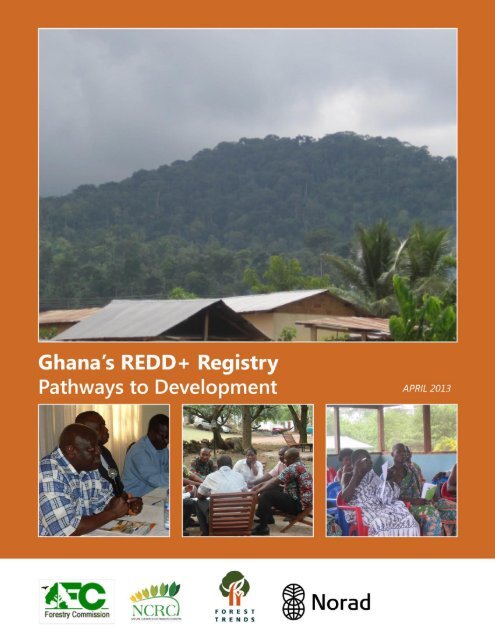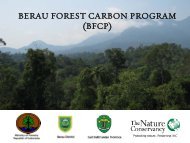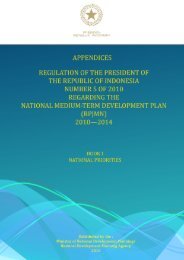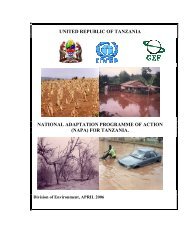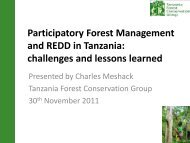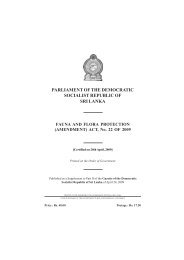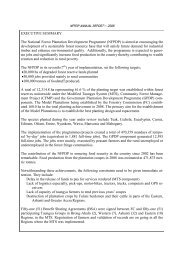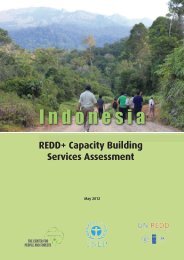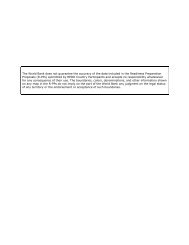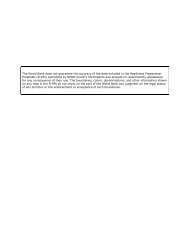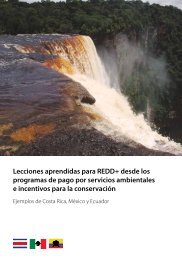PDF - The REDD Desk
PDF - The REDD Desk
PDF - The REDD Desk
You also want an ePaper? Increase the reach of your titles
YUMPU automatically turns print PDFs into web optimized ePapers that Google loves.
Acknowledgements<br />
In January 2012, Ghana’s National <strong>REDD</strong>+ Secretariat created a technical working group (see Annex 1) to advise the<br />
development of a <strong>REDD</strong>+ registry for the country. As part of its deliberative process, the working group delegated a<br />
core team to draft a concept note about <strong>REDD</strong>+ registries and to make a set of recommendations for Ghana which<br />
would serve to guide the <strong>REDD</strong>+ Secretariat and National <strong>REDD</strong>+ Working Group on the development of such a<br />
registry. <strong>The</strong> authors are therefore most grateful to all of the members of this working group for the rich discussions,<br />
insights, guidance, and comments that informed this document. <strong>The</strong> process of thinking about a <strong>REDD</strong>+ registry for<br />
Ghana (and other African countries) has also benefitted extensively from the specific collaboration and insights of a<br />
few key people, including: Daniel Benefoh Tutu of Ghana’s Environmental Protection Agency (EPA), Jacob Olander of<br />
EcoDecision (Ecuador), Joerg Seifert-Granzin of Mesa Consult (Bolivia), Mariano Cenamo of IDESAM (Brazil), and John<br />
Mason of Nature Conservation Research Centre (Ghana). <strong>The</strong> authors are also grateful to Mr. Robert Bamfo, the<br />
Head of Ghana’s Climate Change Unit and National <strong>REDD</strong>+ Secretariat, for his leadership and support in this process.<br />
Finally, the authors acknowledge the work of Climate Focus and KFW for their working paper, “National <strong>REDD</strong>+<br />
Registries” (O’Sullivan et al. 2011) and a presentation by John O. Niles of the Tropical Forest Group on “Nesting<br />
<strong>REDD</strong>+ with Subnational Registries” for providing the critical foundation for this concept note.
Ghana’s <strong>REDD</strong>+ Registry<br />
Pathways to Development<br />
Rebecca Ashley Asare, Yaw Kwakye, and Ernest Foli<br />
April 2013
Table of Contents<br />
Acknowledgements ....................................................................................................................2<br />
Table of Contents ........................................................................................................................4<br />
1. Background & Overview of <strong>REDD</strong>+ Readiness in Ghana ...........................................................1<br />
2. Ghana’s Registry Development Process ...................................................................................1<br />
3. Introduction to <strong>REDD</strong>+ Registries ............................................................................................2<br />
4. Managing & Structuring a <strong>REDD</strong>+ Registry ...............................................................................4<br />
Who Manages the Registry ............................................................................................................. 4<br />
5. Operating a Registry ................................................................................................................5<br />
Registry Platforms & Technology ...................................................................................................... 5<br />
What information is captured ......................................................................................................... 6<br />
Flow of Information ........................................................................................................................... 8<br />
Buffers ................................................................................................................................................ 9<br />
Implementation- Phased Approach .................................................................................................. 9<br />
6. Financing a Registry ............................................................................................................... 11<br />
Costs & Financing of the Registry ................................................................................................... 11<br />
7.Registry Linkages and Scale .................................................................................................... 11<br />
8. Rules & Regulations .............................................................................................................. 12<br />
Regulations ...................................................................................................................................... 12<br />
Fees and Taxes ................................................................................................................................. 13<br />
Requiring Compliance with International Standards ..................................................................... 13<br />
9. Crucial Elements of a Functional Registry .............................................................................. 14<br />
Transparency & Efficiency ............................................................................................................... 14<br />
Environmental Integrity .................................................................................................................. 14<br />
Accountability .................................................................................................................................. 15<br />
10. Ghana’s Road Map: Recommendations & Way Forward ..................................................... 15<br />
Annex 1: Ghana Working Group Participants ............................................................................ 17
1. Background & Overview of <strong>REDD</strong>+ Readiness in Ghana<br />
<strong>The</strong> emerging mechanism of Reducing Emissions from Deforestation and Forest Degradation (<strong>REDD</strong>+) presents<br />
opportunities for developing countries to contribute to climate change mitigation and benefit from associated<br />
financial flows. Specifically, such actions and measures are meant to result in the reduction of carbon dioxide<br />
emissions from forests, either by preventing their destruction or degradation, or by enhancing carbon stocks through<br />
tree planting, conservation, or sustainable management.<br />
Ghana has been an active participant in this international process aimed at mitigating climate change, which poses a<br />
major threat to humankind on a global scale. In the quest to contribute to the realization of the goals and objectives<br />
of <strong>REDD</strong>+, the Government of Ghana, through designated state institutions, has been collaborating closely with key<br />
international and local partners to implement this evolving global mechanism.<br />
<strong>The</strong> Forest Carbon Partnership Facility of the World Bank is currently providing support in the sum of US$3.4 million<br />
for the implementation of a 4-year <strong>REDD</strong>-Readiness Preparation Proposal (R-PP), which seeks to position Ghana to<br />
effectively participate in the evolving international <strong>REDD</strong>+ mechanisms. Although many aspects of the international<br />
system are yet to be determined, it is clear that for <strong>REDD</strong>+ to work it must enable results-based payments, either<br />
through markets or fund-based transactions. To facilitate transactions of this nature, detailed regulation and<br />
monitoring will be essential. Box 1 outlines the tasks and activities associated with the implementation phase of<br />
Ghana’s R-PP.<br />
In Step 2, the establishment of a carbon accounting registry is clearly identified as one of the activities to be<br />
implemented during the Pilot and Testing stage of Ghana’s R-PP process. To date, crucial activities which have<br />
implications for the establishment of a carbon registry are underway, including setting of baselines and putting in<br />
place an effective MRV system for determining levels of success.<br />
In addition, seven pilot projects have been identified for implementation under the <strong>REDD</strong>+ readiness preparation<br />
process, which should provide an opportunity for field testing the yet-to-be-established registry at various stages of<br />
its development.<br />
2. Ghana’s Registry Development Process<br />
In January, 2012, Ghana’s <strong>REDD</strong>+ Secretariat, located at the Climate Change Unit of the Forestry Commission, took<br />
the initiative to move the registry development process forward using a working group approach. This working group<br />
(see Annex 1 for list of participants), which met for the first time during the same month, is made up of <strong>REDD</strong>+<br />
decision-makers, <strong>REDD</strong>+ experts, and key stakeholders from government and civil society. While the aim of the first<br />
meeting was to develop a baseline understanding of central concepts and issues about registries, the working group’s<br />
ultimate aim is to inform and recommend a pathway for <strong>REDD</strong>+ registry development in Ghana which the<br />
government can use to guide the process.<br />
At the first meeting, the working group designated a core team and charged them to follow up on critical questions<br />
and issues (seeking information and advice from other <strong>REDD</strong>+ countries and entities with registry experiences), and<br />
to draft a <strong>REDD</strong>+ Registry concept note. It was further agreed that the working group would then reconvene to<br />
review and finalize the concept note, and then hand it back to the Secretariat to use as a guide for the development<br />
of a functional and appropriate <strong>REDD</strong>+ registry for Ghana.<br />
This document therefore represents the draft concept note, as put together by the core team. It has benefitted from<br />
the team’s own internal discussions, as well as consultations (both formal and informal) with other private sector<br />
entities, international <strong>REDD</strong>+ experts, and expert <strong>REDD</strong>+ institutions based in Brazil, the Democratic Republic of<br />
Congo (DRC), Ethiopia, Kenya, and Tanzania.<br />
1
Box 1: Ghana’s R-PP Implementation Phases<br />
<strong>The</strong> R-PP document represents Ghana’s ongoing efforts to get ‘ready’ for a future mechanism for <strong>REDD</strong>+. It presents a<br />
three-step approach to <strong>REDD</strong>+ strategy development and establishment of the technical, policy, legal, management and<br />
monitoring arrangements necessary to enable Ghana to fully participate in a mechanism for <strong>REDD</strong>+. Implementation of<br />
the R-PP is anticipated to continue through 2013. <strong>The</strong> steps of this stage will include:<br />
Step 1: Analysis, Preparation and Consultation<br />
Detailed analysis of <strong>REDD</strong>+ policy, legal and technical requirements<br />
Setting of the Reference Emissions Level (REL)<br />
Confirmation of institutional roles, responsibilities and oversight for <strong>REDD</strong>+, establishment of the entity responsible<br />
for MRV<br />
Selection of potential pilots / demonstration activities<br />
Continued consultation, information sharing and awareness raising on <strong>REDD</strong>+ strategy, legislative and institutional<br />
proposals<br />
Finalization of <strong>REDD</strong>+ strategy (to progress towards <strong>REDD</strong>+ readiness)<br />
Step 2: Piloting and Testing<br />
Initial capacity building for pilots<br />
Establishment of pilots / demonstration activities<br />
Establishment of carbon accounting registry<br />
Testing of carbon measurement, accounting and MRV procedures<br />
Consultation around demonstrations and pilots<br />
Consultation on potential <strong>REDD</strong>+ policies, decisions and actions<br />
Training Needs Analysis for full <strong>REDD</strong>+ implementation<br />
Step 3: Becoming Ready<br />
Approval of any new legislation (e.g. carbon rights) and legal texts (as required)<br />
Finalized financing mechanisms, procedures, audit and controls<br />
Finalized operating procedures for MRV entity<br />
Recruitment of staff<br />
Training and capacity building on the development and technical aspects of <strong>REDD</strong>+<br />
Operational plan to scale up <strong>REDD</strong>+ in Implementation Phase<br />
3. Introduction to <strong>REDD</strong>+ Registries<br />
Registries for national carbon accounting and associated transactions constitute a crucial part of the infrastructure<br />
needed for realizing and consolidating <strong>REDD</strong>+. If designed in a comprehensive and transparent manner, a registry<br />
ensures that all the relevant data and information linked to <strong>REDD</strong>+ are captured, processed and stored in a<br />
centralized repository which is accessible to various categories of stakeholders and end-users for decision making<br />
purposes. This can be done at multiple scales, including national to sub-national and project levels.<br />
A <strong>REDD</strong>+ registry is a data management platform that integrates technology, policies, and operational procedures to<br />
document, approve and track the development, compliance, performance, purchase, and retirement of emissions<br />
reductions (or removals) through either national, regulatory, or voluntary markets or systems. <strong>REDD</strong>+ registries aim<br />
to serve as a repository of reliable, easy-access information, to ensure accurate accounting of emissions reductions<br />
from projects or programs, and to foster compliance with established regulations and standards. As such, a <strong>REDD</strong>+<br />
registry enables a country (or jurisdiction) to be fully informed of all <strong>REDD</strong>+ activities taking place within its<br />
boundaries, to vouch for the quality, value, and impact of projected or reported emissions reductions or removals,<br />
2
and to follow the issuance of <strong>REDD</strong>+ credits/units and the issuance of results based payments, irrespective of where<br />
the units are transacting within a market framework.<br />
In existing carbon markets, transactions are documented in registries where carbon offsets can be bought, sold or<br />
retired, and all these dealings tracked in real time and validated accordingly. <strong>The</strong> latter is particularly crucial for<br />
ensuring environmental integrity across different <strong>REDD</strong>+ initiatives and also promoting transparency and appropriate<br />
benefit sharing amongst stakeholders.<br />
Figure 1: Flow of Information in a Registry<br />
Information<br />
uploaded<br />
Assessed<br />
for<br />
compliance<br />
Stored in<br />
database<br />
Open to<br />
public<br />
Reported,<br />
monitored,<br />
verified<br />
Emissions<br />
Reductions<br />
Transactions,<br />
retirement<br />
recorded<br />
For most countries, the registry will be database driven, though the database does not have to be especially complex.<br />
Despite the fact that most of the attention to date has focused on registry technology and systems, at its core, a<br />
registry is simply an enabler of policies and rules. <strong>The</strong>refore, the most complex elements of registry development are<br />
likely to be the policies and government finance requirements which are needed to support registry development<br />
and roll-out.<br />
<strong>The</strong>re are five critical functions or elements to achieving a successful <strong>REDD</strong>+ registry:<br />
1. transparency;<br />
2. accountability;<br />
3. efficiency;<br />
4. environmental integrity;<br />
5. compliance.<br />
A registry that cannot meet these five criteria will quickly lose the confidence of key <strong>REDD</strong>+ stakeholders, including<br />
project developers, communities, buyers, validators, etc., and will ultimately undermine its own objective.<br />
To date, there are very few operational <strong>REDD</strong>+ registries in Africa. While many countries are exploring options in light<br />
of their <strong>REDD</strong> Readiness plans (R-PP), the DRC is the only African country engaged in <strong>REDD</strong> that has developed and<br />
begun to pilot a registry system. Box 2 gives an overview of Ghana’s aims in developing a registry. At the global scale,<br />
however, many countries are articulating national and jurisdictional (sub-national) registries, depending on their<br />
respective <strong>REDD</strong>+ architectures. Registries are also being used in the voluntary market and in other sub-national<br />
markets focused on jurisdictional <strong>REDD</strong>+. Along similar lines, registries have been developed for the Clean<br />
Development Mechanism (CDM); the main registry sits in Bonn, Germany, while Ghana’s national list of CDM projects<br />
is housed at the Ministry of Environment, Science and Technology (MEST). Registries are also being developed for<br />
Nationally Appropriate Mitigation Actions (NAMA), though in Ghana a NAMA registry has yet to be developed as<br />
NAMAs are only in the early stages of articulation. Furthermore, African countries are engaged in national<br />
accounting and reporting of national emissions, and as such are in the process of developing registries to monitor and<br />
to compile sector-level emissions data for reporting to the United Nations Framework Convention on Climate Change<br />
(UNFCCC). In Ghana, this is conducted by the Environmental Protection Agency (EPA).<br />
3
Box 2: Aims and Objectives of Ghana’s Proposed <strong>REDD</strong>+ Registry<br />
In Ghana, the proposed <strong>REDD</strong> Registry has the following aims:<br />
Enable efficient and equitable development of <strong>REDD</strong>+ projects through a transparent process<br />
Develop regulations and procedures to guide the development of <strong>REDD</strong>+ projects<br />
Ensure that all projects meet national standards and fit into international frameworks<br />
Facilitate integrated accounting and reporting of GHG emissions and removals<br />
Provide a transparent platform for the public to access information about all <strong>REDD</strong>+ projects<br />
It is also envisaged to serve the following objectives:<br />
Ensure clarity around the nature and ownership of <strong>REDD</strong>+ assets to efficiently and confidently enable<br />
the transaction of performance payments<br />
Promote transparency, credibility, and ensure legality (prevent money laundering and other illegal<br />
activities )<br />
Promote environmental integrity (avoid double-counting, manage leakage and REL setting, etc.)<br />
Ensure respect for social and environmental standards and safeguards<br />
Ensure a contribution to the national readiness process (information sharing and capacity building)<br />
4. Managing & Structuring a <strong>REDD</strong>+ Registry<br />
Who Manages the Registry<br />
<strong>The</strong> responsibility of operating and managing a registry is likely to fall to more than one institution or agency as the<br />
scope of expertise can be technically and functionally diverse. <strong>The</strong>se roles could be filled by a government agency or<br />
department, or a third party entity (like a private sector company, an NGO, or a research institution). At a minimum,<br />
a fully operational <strong>REDD</strong>+ registry should include:<br />
1. A decision-making body that administers the<br />
day to day coordination, analysis, monitoring<br />
and general operations of the registry;<br />
2. A GIS /Remote Sensing centre of operation<br />
that generates or compiles forest data for<br />
monitoring, reporting, and verification (MRV);<br />
3. A systems operator that is responsible for<br />
developing / operating the database platform<br />
and potential web-based interface through<br />
which a registry would function.<br />
System<br />
operation<br />
Following a phased approach, the management and<br />
decision making body would likely come first, followed<br />
by a forest monitoring and MRV unit (or these could be<br />
separate units), and finally by a systems operator as the<br />
system develops from a basic structure to a more sophisticated data-management facility.<br />
Forest<br />
Monitoring &<br />
MRV Auditing<br />
Management<br />
and Administration<br />
At the core of a registry is the administrative body which will manage day to day operations and decision making.<br />
This unit would draft or coordinate the development of the rules, protocols, and associated template documents of<br />
the registration process, which could take on a phased registration approach. It would receive and store information<br />
and documents, and be responsible for quality control—scrutinizing the quality and credibility of information and<br />
documents submitted to the registry and ultimately approving or denying requests and submissions from prospective<br />
developers or buyers. In fulfilling these responsibilities, the registry’s administrative body can perform these tasks<br />
itself or collaborate with other organizations.<br />
4
With some tasks, input from a committee of experts, validation/verification by an international standard, or<br />
contracting to a third party may improve the efficiency and cost-effectiveness of the process, in addition to ensuring<br />
the integrity of registered projects. For example, due diligence checks are more effectively conducted by banks, who<br />
perform this service on a day to day basis, as compared to governments which are typically not organized to check<br />
whether a business is legally incorporated, financially sound, and engaged in good business practices. Requiring that<br />
the Voluntary Carbon Standard (VCS) validates the content and feasibility of a Project Design Document (PDD) prior<br />
to its “approval” by a registry is another way to ensure that prospective projects are sound and in compliance with<br />
international standards. As projects advance into implementation, the registry body could also require that<br />
recognized international verifiers (e.g. VCS) verify the project’s reported emissions reductions or removals, thereby<br />
ensuring access to international markets or funds.<br />
Box 3: DRC’s <strong>REDD</strong> Registry<br />
<strong>The</strong> DRC is the first country in Africa to pilot a <strong>REDD</strong> registry. <strong>The</strong> DRC Registry system is structured such that day to<br />
day administration of the Registry is performed by a Technical Commission under the National <strong>REDD</strong> Committee<br />
(Ministry of the Environment, Conservation and Tourism). <strong>The</strong> technical commission has developed an<br />
arrangement with ProCredit Bank to conduct all due diligence checks on all prospective project developers, and it<br />
requires that any project meets both national and international standards, including VCS validation and verification<br />
for projects, and CCBA for social and biodiversity co-benefits. Forest monitoring for the Registry is carried out by<br />
the DRC National Forest Monitoring System. <strong>The</strong> online operational system is being developed (currently in pilot<br />
phase) by the FAO (UN-<strong>REDD</strong>) and partners. This system uses Brazil’s open-source TerraAmazon platform<br />
(renamed TerraCongo) to provide GIS, image processing, database management and data access functionalities.<br />
5. Operating a Registry<br />
Moving from the concept of a <strong>REDD</strong>+ registry and its management structure to actual implementation and<br />
operationalization raises a new series of questions and choices. Countries must choose the type of platform and<br />
technology that is most appropriate for their national circumstances. Countries have to determine the type and flow<br />
of information to be captured by the registry. Countries need to acknowledge and cater for the inherent risks in<br />
<strong>REDD</strong>+ projects and set up appropriate buffer accounts. And finally, countries need to figure out how to balance<br />
timely implementation with the costs and time associated with full-scale functionality.<br />
Registry Platforms & Technology<br />
For the registry platform and its associated technology there are three options:<br />
1. using proprietary software and systems, which come at a cost<br />
2. choosing open-source software to build a platform<br />
3. forgoing a national or jurisdictional registry and simply requiring projects to register under the VCS system or<br />
an alternative registry<br />
<strong>The</strong> first two options are the most realistic, whereas the third option is likely to pose many problems and challenges<br />
for African nations. Under the third option, a project would not be registered until it had reached validation under<br />
the VCS, a process that could take years. Not only would governments or other jurisdictions lose oversight, but they<br />
might also lose potential revenue. Currently, Markit provides the registry for the VCS and charges projects<br />
approximately $0.12/tCO2 registered.<br />
Proprietary environmental registries that provide licenses and services have the advantage of being able to provide a<br />
tailored package that ensures security and disaster recovery. For example, Ghana could choose to purchase an<br />
operating license and then receive training from the registry company in how to operate the system. Along the way it<br />
could request further support and technical backstopping. Alternately, Ghana could opt to hire the company to host<br />
and operate the registry on its behalf. While potentially attractive, companies that develop and run environmental<br />
5
egistries are for-profit businesses whose model aims to make money, resulting in potentially costly contracts that<br />
necessitate long term commitments.<br />
Unlike proprietary software or systems, which come with restrictive copyright licenses and a price tag, open-source<br />
software can be given away for no charge. Comparatively, open source software is seen as providing better value in<br />
terms of: 1) lower costs and long-term affordability, 2) security, 3) flexibility (e.g. no vendor 'lock in'), 4)<br />
interoperability, 5) better quality, and 6) transparency (citation Casson and Ryan). Yet one of the greatest barriers<br />
facing wide acceptance of open-source software relates to the lack of technical and general support. It is interesting<br />
to note that in 2009, the US White House switched its content management system (CMS) from a proprietary system<br />
to an open-source CMS 1 .<br />
<strong>The</strong> DRC opted for an open source system that essentially links a simple, web-based database interface to its forest<br />
monitoring interface, which is called TerraCongo. TerraCongo was adapted from Brazil’s existing Registry and Forest<br />
Monitoring system, called Terra Amazon. Brazil’s forest monitoring system is a remote sensing and GIS based<br />
information system that uses the National Institute for Space Research (INPE) TerraLIB GIS functions<br />
(http://www.terralib.org/) and SPRING software (http://www.spring.org.br/). Both of these Brazilian frameworks can<br />
be downloaded for free.<br />
While suitable tools for a registry, they are by no means a requirement. DRC is running a simple web-based database<br />
interface, which links to its forest monitoring toolbox (TerraCongo), but a country could alternatively link this<br />
database to Google Earth, or to another forest monitoring platform.<br />
Table 1: Advantages & Disadvantages of Proprietary and Open Source Systems<br />
Proprietary<br />
Open Source<br />
Advantages<br />
Country-specific, custom made<br />
package<br />
Provides security<br />
Option to host & operate<br />
Technical training & backstopping<br />
for in-country operation<br />
Disaster recovery guarantee<br />
Low cost<br />
Long term affordability<br />
High level of security<br />
Flexibility - no vendor lock in<br />
Interoperability<br />
Better quality<br />
Transparency<br />
Disadvantages<br />
Restrictive copyright licensing<br />
High cost<br />
Vendor dependent<br />
Security level restricted by inhouse<br />
knowledge, expertise<br />
Non-compatibility with other<br />
systems<br />
Lack of technical & operational<br />
support<br />
What Information is Captured<br />
Over time, a registry could oversee national, jurisdictional, private or community-based projects or programs focused<br />
on emissions reductions or removals that seek to engage in carbon funds, compliance markets, voluntary markets,<br />
bilateral programs, or national emissions reductions programs. Potential attributes of a project or a program which a<br />
registry would capture, assess, monitor, and share might include information about project proponents, project<br />
financing, the location of a project, compliance with national or international standards, level of project<br />
advancement, and market linkages. Table 2 (below) outlines some of these potential attributes.<br />
1 Wikipedia. May 28 2012. (http://en.wikipedia.org/wiki/Open-source_software#cite_note-25 Sourced from: Geoff Spick (@Goffee71) (2009-10-<br />
26). "Open Source Movement Finds Friends at the White House". Cmswire.com. Retrieved 2012-03-25.<br />
6
Table 2: Potential Registry Stages and Associated Information Requirements<br />
STAGE<br />
Project Registration<br />
Project Design<br />
Project Implementation<br />
Market Linkages<br />
Conflicts / Complaints<br />
TYPE OF INFORMATION SUBMITTED<br />
Names and information about project proponents and partners<br />
Legal and fiduciary information about proponents and their compliance with due diligence<br />
check<br />
Project Idea Note (PIN) document, including location and GPS coordinates<br />
Indication of standard(s) the project is applying to<br />
Explanation of project financing by sources and amounts<br />
Registration Either Accepted or Denied by Registry Management / Admin body<br />
Project Design Document (PDD), including:<br />
- GPS coordinates of project boundaries and reference area<br />
- Carbon stock information for each land cover type (discreet classes)<br />
- Projected avoided emissions (as tCO2 or hectares)<br />
- Description of project activities<br />
- Detailed implementation plan<br />
- Description of land and tree tenure, ownership, proof of ownership<br />
Prior informed consent from all stakeholders, including all communities in project area<br />
Geo-located with forest monitoring system to show no overlap with other projects<br />
Validation report by Standard (e.g. VCS)<br />
Validation report on co-benefits (e.g. CCBA)<br />
Validation of compliance with social and environmental safeguards<br />
Official start date of project<br />
Description of the status of project/program implementation according to registry set time<br />
frame<br />
Yearly accounting of avoided emissions (as tCO2 or hectares) or carbon benefits realized<br />
Documentation of external validator’s report or national MRV validation of project emissions<br />
reductions<br />
Connects to carbon markets or other international carbon/ emissions reduction registries to<br />
facilitate transfer or purchase of verified carbon units (VCU) or other types of credits.<br />
Enables online tracking of credits, including purchase, transfer (if applicable), and retirement of<br />
credits.<br />
Platform and mechanism for registration of complaints or grievances and oversees appropriate<br />
redress mechanism.<br />
To enable the process, regulations, forms and templates will be required to facilitate submissions and tracking of<br />
project compliance and status. <strong>The</strong>refore, it would be the role of the <strong>REDD</strong>+ Secretariat (registry management body)<br />
to set the step-wise process and create the requisite criteria and templates through which a registry would operate.<br />
This body would also need to establish time frames within which each project or program would have to comply and<br />
move a project forward, otherwise they lose their “registered” status.<br />
A hypothetical example is that a project could be required to submit a Project Development Document (PDD) within 3<br />
years (maximum) of submitting the Project Idea Note (PIN). <strong>The</strong> registry would be able to track project advancement<br />
within this time frame and alert authorities and proponents to impending deadlines. Similar to the rule setting and<br />
oversight responsibilities of the Management and Administrative body, the Forest Monitoring or MRV Auditing body<br />
7
would need to check (and update) the declared geo-location of the proposed project, make sure that there is no<br />
overlap with other projects, and make the project visible on a public map, which can be accessed on the registry web<br />
page to promote transparency. <strong>The</strong> body would also check the project’s reported avoided emissions or emissions<br />
benefits to make sure that they comply with national or regional level data. <strong>The</strong> unit could be responsible for the<br />
national validation of a project’s emissions data and then if it is in compliance the results could be, acknowledged on<br />
the registry.<br />
Flow of Information<br />
<strong>The</strong> use of a web-based system enables an iterative process between the body (or bodies) managing the registry,<br />
project proponents, and the public, including community leaders, potential investors, and researchers. Figure 2<br />
shows an example of the flow of information leading to project registration.<br />
Figure 2: Project Registration Process and Information Flow<br />
1. Set rules, makes forms and<br />
guidelines available.<br />
2. Proponent downloads forms,<br />
guidelines.<br />
3. Proponent completes forms and uploads.<br />
Enters required information into online account<br />
template to register.<br />
Registry<br />
Mgmt<br />
Body<br />
4. Management Body receives<br />
information from proponent and<br />
checks for compliance<br />
5. If in compliance, then accepts registration of<br />
proponent. Activates account for proponent, some info<br />
publically available on registry.<br />
Project Registered<br />
6. Project<br />
continues<br />
toward<br />
PDD<br />
Project<br />
Proponent<br />
Web-based Registry<br />
Public View<br />
8
Buffers<br />
Non-permanence risk is one of the most under-acknowledged facets of <strong>REDD</strong>+ projects, especially in the calculation<br />
of potential carbon benefits, and yet non-permanence risk factors are very real. In Africa, forests, standing trees in<br />
the landscape, and tree planting projects face a multitude of risks, including fire, pests and diseases, political<br />
insecurity, poor project management, and climate change (to name only a few factors). Under the VCS, risk is<br />
quantified as being internal, external, or natural (See Table 3).<br />
Table 3: Summary of Potential Non-Permanence Risk Factors<br />
Internal Risks:<br />
Project management, including need for ongoing enforcement to protect carbon stocks and capacity of<br />
management team<br />
Financial viability<br />
Opportunity costs and associated pressures of alternative land uses<br />
Project longevity based on legal agreements or requirements<br />
External Risks:<br />
Land tenure, including ownership and resource access/use rights<br />
Community engagement, consultation of households inside and within 20 km of project boundaries<br />
Political risk, based on World Bank Institute World Governance Indicators, adjusted if country is engaged in<br />
international <strong>REDD</strong>+ readiness initiatives<br />
Natural Risks:<br />
Significance and likelihood of fire, pest and disease outbreaks, extreme weather events such as hurricanes, and<br />
geological risk such as earthquakes and volcanoes.<br />
Source: VCS AFOLU Non-Permanence Risk Tool (2011)<br />
In the case where a project that has received outside investment or has already gone to market loses some of its<br />
<strong>REDD</strong>+ assets as a result of fire or non-performance or some other risk factor, someone will be held liable for the lost<br />
“credits” or projected emissions reductions. <strong>The</strong> goal of a buffer account is to act as a national or sub-national savings<br />
account or insurance package to cover an investor’s losses. In principle, <strong>REDD</strong>+ Registries can facilitate the<br />
establishment of a buffer account and a method for calculating project risk such that projects are not overly<br />
optimistic in calculating projected benefits (and earnings) and investors are able to re-coup their investments when<br />
unforeseen events occur.<br />
Implementation- Phased Approach<br />
In Ghana, there will probably be very few demonstration projects, pilot projects, or site-specific activities generating<br />
(or aiming to generate) emissions reductions for the next few years. <strong>The</strong>refore, tracking these projects as they<br />
develop and any associated transactions should not be that difficult. With some government oversight and<br />
monitoring, it could also depend on the existing VCS registry system to monitor the first credits going to the voluntary<br />
markets.<br />
<strong>The</strong>refore, the most practical option for Ghana is to adopt a phased approach, which would entail starting from<br />
something relatively simple and not aiming to overbuild or overspend too early. A major mistake would be to<br />
develop a high tech, high-cost registry that effectively sits empty due to the lack of projects. Instead, following a<br />
phased approach would allow time to develop the necessary procedures, criteria, monitoring standards, and<br />
safeguards, and to build up capacity for MRV to track what is actually happening on the ground. Initially, Ghana<br />
should be wary of over-spending on the registry at a time when there are very few projects or programs.<br />
9
Table 4: Implementation Phases<br />
Phase 1 - Launching a Registry<br />
Aim Capture core information about all <strong>REDD</strong>+ activities in Ghana to facilitate simple tracking and<br />
compliance.<br />
Establish the precedent that all <strong>REDD</strong>+ activities, projects and programs should be registered<br />
with the <strong>REDD</strong>+ Secretariat.<br />
Capacity Track performance either through tonnes of CO2e reduced or removed (as reported by VCS<br />
registry) or through other metrics or proxies (hectares of avoided deforestation).<br />
Can function whether or not MRV system is fully developed. Where MRV is un-developed would<br />
help to inform MRV development and provide early tracking of activities.<br />
Jump-start the process of establishing <strong>REDD</strong>+ registry policies, standards, procedures, and<br />
safeguards.<br />
Set-Up & Designate registry host (<strong>REDD</strong>+ Secretariat)<br />
Tech <strong>Desk</strong>top registry using Excel or other familiar database programs.<br />
Platform Face to face interactions at Sec. or similar office charged with Administration.<br />
Posting of basic rules, procedures on FC website and in national newspapers.<br />
Forms available at FC office or website<br />
An initial registry could also operate through a more sophisticated, electronic platform.<br />
Require registration under VCS or other international standards so that market transactions and<br />
performance are monitored/registered.<br />
Strengths Avoids excessive costs associated with high-tech registry that will be largely void of any project<br />
activities for early years.<br />
Enables the country to quickly establish a database of information about all activities, projects,<br />
and stakeholders, and helps to prevent unscrupulous actors from engaging in questionable<br />
activities in the name of <strong>REDD</strong>+ without government knowledge. This is very important because<br />
<strong>REDD</strong>+ is in its early days in Ghana and perceptions of failure or negative outcomes (particularly<br />
with communities) could significantly damage the country’s ability to achieve successful <strong>REDD</strong>+<br />
outcomes.<br />
Avoid loss of potential revenue due to “unknown” projects<br />
Enable government to charge fees or percent of emissions reductions to generate operating<br />
income for registry.<br />
Phase 2 - Functional National Registry for Tracking Project Development<br />
Aim Fully operational national registry that enables project registration and monitoring, and is<br />
connected to functional forest monitoring and accounting system.<br />
Capacity Equip to register and monitor <strong>REDD</strong>+ projects through the various stages of project<br />
development, ensuring compliance with national and international standards.<br />
Guides projects to international registries to support market transactions.<br />
Enables tracking of results based payments.<br />
Records outcome of projects and number of <strong>REDD</strong>+ units issued.<br />
Operation of the registry supported by:<br />
Establishment of rules, procedures, and safeguards.<br />
<strong>The</strong> setting of regional and integrated national <strong>REDD</strong>+ reference levels, enabling<br />
performance tracking.<br />
Establishment of a national buffer account.<br />
Platform Web-based data-base platform linked to national forest monitoring system and supported by<br />
established criteria and procedures.<br />
10
Strengths Able to prevent double accounting<br />
Revenue generated from national tax/fee for market transactions on a per ton basis.<br />
Can communicate emissions reductions with other national accounting bodies.<br />
Significantly reduces the risk of illegal activities or negative social impacts<br />
Phase 3 - Participation in National or International Markets or Funds<br />
Aim Registry infrastructure is expanded to participate in international <strong>REDD</strong>+ markets (directly) or<br />
through an established national market in <strong>REDD</strong>+ units.<br />
Capacity As <strong>REDD</strong>+ markets evolve more fully, and if countries opt to establish national markets, then the<br />
registry infrastructure is expanded to facilitate these trade/market transactions.<br />
Platform Same as above, but expanded linkages and scope of operation.<br />
Strengths Supports compliance, monitoring, and tracking of projects from conception, to issuance of<br />
credits, to national and/or international market transaction within a national system.<br />
6. Financing a Registry<br />
Costs & Financing of the Registry<br />
<strong>The</strong>re is very little information available on the costs associated with building and running a national <strong>REDD</strong>+ registry.<br />
Private sector companies are wary of providing cost estimates for their registry services without non-disclosure<br />
agreements. However, informal discussions with technical experts in other leading <strong>REDD</strong>+ countries suggest that<br />
some companies marketing registry development (proprietary, customized registry software) and management could<br />
charge approximately $600,000 to build a registry, and $100,000 per year to operate and provide technical support to<br />
the registry. In addition, these companies may charge a fee of $0.12 per VER sold on international markets. <strong>The</strong>re<br />
are no comparative costs available for Registries developed using open source software and donor support.<br />
Possible sources of funding could include donor governments or international agencies, government budgets, tax<br />
revenue (existing or new ecosystem service user payments), charging all projects a % of their emissions reductions, or<br />
a fee-based registry (e.g. proponents pay as they go). A registry could be funded through any combination of these<br />
options.<br />
<strong>The</strong> risk with donor funding is that it is unlikely to continue in perpetuity. Rather, it could serve as critical start-up<br />
finance to assist in the development or initial contracting for a registry. Charging projects a percentage of emissions<br />
reductions could generate substantial revenue, but not all projects will necessarily engage in voluntary markets and<br />
not all projects will be successful, creating a scenario where a few projects pay for the services rendered to all users of<br />
the system. This model would also fail to bring any revenue early in the process. While it might not result in<br />
substantial sums, projects could be asked to pay fees as they move through compliance and monitoring processes,<br />
which a registry facilitates. Given these cost challenges, it is important that a registry uses a low-cost system that<br />
would enable long term use and sustainability of the system.<br />
7. Registry Linkages and Scale<br />
While a national <strong>REDD</strong>+ registry does not have to adopt international registry structures or standards (like that of the<br />
Voluntary Market, VCS, CCBA), at a minimum, it is important that a <strong>REDD</strong>+ registry is able to fluently link with<br />
international standards and registries so as to gain the confidence of investors and ensure efficient project<br />
development and transactions. As noted above, a national <strong>REDD</strong>+ registry could require project developers to<br />
comply with voluntary market standards, like that of the VCS and CCBA, enabling faster registry roll-out (no lag time<br />
as national standards are debated and legislated) and easy linkages with international mechanisms.<br />
Similarly, a <strong>REDD</strong>+ registry does not necessarily need to incorporate other national climate change initiatives (CDM,<br />
NAMAs, National Emissions Accounting), but using a registry to build compatibility between these initiatives could<br />
11
certainly offer many practical benefits, reducing workloads and accounting challenges. For example, a <strong>REDD</strong>+ registry<br />
could be structured such that it directly informs AFOLU accounting for a country’s National Emissions Accounting.<br />
Furthermore, a <strong>REDD</strong>+ registry should consider how to create linkages with CDM-Forestry projects so that the<br />
emissions reductions associated with carbon stock enhancement connect logically to emissions reductions produced<br />
through plantation establishment.<br />
Registries can be developed at national or sub-national/jurisdictional scales. Key factors in determining which is most<br />
appropriate include: whether a country is a republic or is a federal system with independent states, the human<br />
resource capacity required to develop and manage multiple registries, the financial viability of operating national and<br />
sub-national registries, and the expected number and distribution of emerging or existent <strong>REDD</strong>+ projects and<br />
programs across the country. Essentially, three options exist.<br />
1. To institute sub-national/jurisdictional registries in line with state-level <strong>REDD</strong>+ initiatives (e.g. Brazil).<br />
Accounting at a national level can then be performed by summing the information emerging from each<br />
state’s registry.<br />
2. To develop sub-national registries in particular states/regions if these are the only areas where <strong>REDD</strong>+ will<br />
be piloted, and then potentially scale up to a national registry as the program expands. In federal countries<br />
like Ethiopia or Nigeria this could be an appropriate approach.<br />
3. To develop a national-level registry that covers all <strong>REDD</strong>-able areas of the country, but could incorporate<br />
data filters that enable managers/operators to assess project development and emissions reductions at<br />
various scales.<br />
8. Rules & Regulations<br />
<strong>The</strong> most complex elements of registry development are likely to be the policies and government finance<br />
requirements which are needed to support registry development and roll-out. In addition, standards must be set or<br />
adopted to ensure the value of <strong>REDD</strong>+ assets, and avoid a situation where the value or quality of emissions<br />
reductions from one project has greater legitimacy than those claimed from another project.<br />
Regulations<br />
A <strong>REDD</strong>+ registry should be supported by guiding policies and regulations that set the criteria and process for <strong>REDD</strong>+<br />
accreditation. This includes determining the type of information that should be disclosed, and regulating what is<br />
made publically available through the registry and what remains confidential within the registry. Further, registry<br />
regulations should necessitate compliance with other national policies, rules, and laws, and facilitate issuance of fees,<br />
levies or taxes.<br />
In many countries, a registry will require legal backing in the form of Ministerial-level policies and associated<br />
regulations (or acts) so that the registry has the power to make decisions, and project proponents are compelled to<br />
follow the established rules. In the DRC, the National <strong>REDD</strong> Coordination drafted an official document, the<br />
“Procedural Manual for Compliance with National <strong>REDD</strong>+ Accreditation” which effectively spells out the criteria and<br />
process for engaging in <strong>REDD</strong> and the associated role of the registry. <strong>The</strong> Ministry of Environment, Conservation of<br />
Nature, and Tourism then issued a Ministerial Order providing backing to the process and criteria, including the<br />
registry.<br />
Depending on the country and the nature of the R-PP process, the pathway to establishing a full legal framework for<br />
<strong>REDD</strong>+ and a registry is likely to take time. Whereas registry implementation should not be held up by a slower legal<br />
process, which would likely be the case in Ghana and many other African countries, mandates, roles, criteria,<br />
processes, fees, and procedures need to be well defined and consequences for non-compliance articulated. Hence,<br />
comprehensive guidelines in the form of a detailed manual, with backing from the appropriate Ministry (or lead<br />
body), will greatly strengthen the registry process early on. It is also worth noting that most projects today require a<br />
12
“Letter of No Objection” from the Designated National Authority (DNA) to be able to engage in voluntary markets or<br />
other funds. At the national or jurisdictional level, issuance of this letter should be contingent upon registration and<br />
compliance, so as to further strengthen the authority of the registry.<br />
In the future, when African countries have moved through the R-PP process and the associated piloting and testing<br />
periods, there will come a time when enactment of comprehensive legislation will be necessary to support regulated<br />
carbon assets and carbon trading. While the focus is usually on the legal ownership of the carbon asset and the right<br />
to benefit, such legislation should also support registry rules and procedures.<br />
Fees and Taxes<br />
As noted earlier, registry development and operation is not necessarily an inexpensive process. Given that project<br />
developers and stakeholders stand to benefit considerably from the myriad services that a <strong>REDD</strong>+ registry provides,<br />
there is ample ground to consider a fee-based approach to registration and compliance. Attaching fees to initial<br />
registration, the procurement of forms, or other aspects of compliance (like third party due diligence checks) will<br />
encourage serious stakeholders with well thought-out project ideas and discourage proponents who have not taken<br />
the time to think through the viability of their business-case. Fees could be stratified, based on the origin or type of<br />
project developer (e.g. a community initiative, as compared to a Ghanaian company or a non-Ghanaian private sector<br />
entity).<br />
It is highly unlikely that all registered <strong>REDD</strong>+ projects will come to a financial payout, but the hope is that some<br />
projects will be able to benefit from a market transaction. Governments that have supported or facilitated <strong>REDD</strong>+<br />
should also benefit in such transactions. Taxes are inherently unpopular, but most governments already have<br />
established taxation mechanisms or levies that target major financial transactions across sectors, and this could come<br />
to include <strong>REDD</strong>+ transactions. In addition, legislation could enable <strong>REDD</strong>+ authorities to specifically earmark a<br />
percentage of emissions reductions or a portion of the revenue from carbon transactions to support <strong>REDD</strong>+<br />
structures and services, like that of the registry. This type of revenue could prove to be critical when donor support<br />
for <strong>REDD</strong>+ has waned, but the national or jurisdictional structures for <strong>REDD</strong>+ still require operational support. <strong>The</strong><br />
key to setting fees, taxes, or levies is establishing rates which are fair, but do not discourage or cripple project<br />
development, investment, or implementation.<br />
Requiring Compliance with International Standards<br />
In addition to thinking about national or jurisdictional regulations or guidelines, international standards, like those<br />
used in the Voluntary Market, are vital for the establishment of registries and for ensuring conformity between<br />
national and international rules (See Section 7: registry Linkages & Scale). International standards, like the Voluntary<br />
Carbon Standard (VCS) detail the requirements, rules and specifications for how emissions reductions or removals in<br />
carbon projects are to be quantified, monitored, reported and verified. Standards ensure that the carbon offsets<br />
generated by a project are scientifically credible and robust, have a real impact on the atmosphere, and are fungible.<br />
Standards also serve as the rulebook for methodology 2 developers when designing new carbon accounting<br />
methodologies.<br />
When used together, international standards and a <strong>REDD</strong>+ registry partially mitigate the ‘changing goalpost’ problem.<br />
While countries take the time to set their own national regulations and procedures, they can rely upon international<br />
standards to set the rules for early <strong>REDD</strong>+ projects, ensuring the value and robustness of the developing credits. In<br />
addition, should an international compliance market come online, it is likely that it will adopt (or adapt) existing<br />
international standards within the context of national circumstances.<br />
2 Methodologies are developed and validated to meet the requirements of a given standard for a given project type. A methodology delineates<br />
the steps a project developer must follow to demonstrate additionality and the baseline scenario, and describes which GHG sources, sinks, and<br />
reservoirs will be included and how they will be measured and monitored to calculate net GHG emission reductions. Some offset systems, which<br />
do not allow independent methodology development, combine standards and methodologies into single documents, which are sometimes<br />
termed protocols.<br />
13
9. Crucial Elements of a Functional Registry<br />
It is no secret that critics of <strong>REDD</strong>+ anticipate many short-comings and challenges to its success. Many of the<br />
criticisms are based on the assumption (not necessarily unfounded based on past track records) that transparency,<br />
equity, and environmental integrity will be compromised by governments and entities that lack the capacity or the<br />
will to change the current deforestation/degradation paradigm. As mentioned in the introduction, a <strong>REDD</strong>+ registry<br />
plays an important role in ensuring that the <strong>REDD</strong>+ process is honest, transparent, and efficient, and that it ensures<br />
environmental integrity, accountability, and compliance with requirements and standards. This section looks at these<br />
concepts in greater detail.<br />
Transparency & Efficiency<br />
Across Africa, the forestry sector in many countries has been strongly criticized over the years for a lack of<br />
transparency and efficiency, leading to the prevalence of illegal practices and activities. Given that <strong>REDD</strong>+ is meant to<br />
serve as a large-scale incentive to alter business as usual practices and modes of operation, which have either directly<br />
or indirectly facilitated deforestation and degradation, a transparent and efficient registry system and process is<br />
absolutely essential to building confidence in <strong>REDD</strong>+ efforts and assets. Box 4 highlights critical tenets of a <strong>REDD</strong><br />
registry.<br />
Box 4: Important Tenets of a Transparent, Efficient, and Functional Registry<br />
• Centralized storage of information and tracking<br />
• Platform that is easily accessible by stakeholders and the public<br />
• Low transaction costs, but appropriate fees to ensure serious engagement and sustainability<br />
• Clear guidelines for reporting and registry account management<br />
• Many functions and types of information publically accessible<br />
• Other classified information limited to account holders, regulators, and managers to protect privacy<br />
• Real time record of compliance, performance, unit ownership<br />
• Transaction history available by customer, units and unit balances<br />
• Tracking of co-benefits and safe-guards<br />
• A portal/pathway for lodging grievances, questions, complaints, disputes that are responded to in a<br />
timely manner following established procedures<br />
• Scalable infrastructure can integrate with other registries / outside markets as need evolves<br />
Without a transparent process, critical stakeholders, including donors, investors, or buyers, will lack confidence in the<br />
registry system itself and ultimately in the integrity or value of the <strong>REDD</strong>+ credits (units) evolving out of the system.<br />
As a result, projects could fail if they try to enter the voluntary market and investors and buyers prefer to invest in<br />
other countries.<br />
Environmental Integrity<br />
One of the most important aspects of a registry system is that it guarantees the environmental integrity and validity<br />
of emissions reductions associated with the national or jurisdictional <strong>REDD</strong>+ initiative. Thus, a registry sets up checks<br />
to make sure that the avoided deforestation, avoided degradation or enhancements of carbon stocks that are<br />
projected or reported are accurate. In doing so, a registry greatly reduces the risk of double accounting, either<br />
between projects or between national and sub-national jurisdictions (See Figure 3). It can also serve to assign units<br />
within national <strong>REDD</strong>+ schemes to individual or collective rights holders or beneficiaries, not only reducing project<br />
development transaction costs, but also addressing potential disputes over rights and equity.<br />
14
Figure 3: Double Counting of Avoided Emissions<br />
Double counting of 15 million tons<br />
CO2e<br />
Project A:<br />
Project B:<br />
A good registry prevents over-reporting or overselling<br />
of emissions reductions units, and it can<br />
ensure that units do not exceed the national or subnational<br />
reference scenario. A registry linked to a<br />
functional forest monitoring system will help to<br />
account for and manage leakage from projects, and<br />
a registry facilitates the creation of a national or<br />
jurisdictional buffer account to accommodate risks.<br />
130 million<br />
Accountability<br />
tons CO2e 100 million tons<br />
A registry should carry out or facilitate (through<br />
CO2e<br />
third-party entities) checks of project documents<br />
and registration materials to make sure that they<br />
are legitimate, including due diligence checks on<br />
project developers. It should define a step-by-step<br />
approval or registration process to ensure that projects or programs are in compliance with approved regulations and<br />
procedures. <strong>The</strong>se rules can either be based on national regulations or on international standards (like those used in<br />
the voluntary market), or both. With regard to accountability, a phased approach that initially relies upon<br />
international standards and procedures could be very useful while the national or state government moves through<br />
the process of writing and approving regulations and implementation legislation.<br />
A registry that does a poor job on this front risks the following challenges, which could greatly undermine the <strong>REDD</strong>+<br />
process:<br />
<br />
<br />
<br />
<br />
<br />
<br />
<br />
Illegitimate entities engaged in questionable activities (e.g. money laundering, carbon cowboys)<br />
Varied methods for quantifying avoided emissions / removals (e.g. comparing apples with oranges)<br />
Private sector view that working in the country is risky<br />
Project credits sold which cannot be captured under national reporting<br />
Haphazard project development (e.g. government is not aware of on-going initiatives)<br />
Loss of potential tax / carbon revenue that could otherwise benefit the state and support <strong>REDD</strong>+<br />
Adoption of benefit sharing arrangements that might not meet acceptable national standards.<br />
10. Ghana’s Road Map: Recommendations & Way Forward<br />
This concept note attempts to outline the various registry development choices and options in the hopes of helping<br />
Ghana, and other African countries, select a nationally appropriate pathway to registry implementation and<br />
operation. Table 5 outlines some of the major decision points of a registry, and makes Ghana-specific<br />
recommendations based on the country’s particular geographic and political characteristics, capacity, financial<br />
resources, and level of <strong>REDD</strong>+ development.<br />
In making these recommendations, the authors’ aim is not only to provide decision-making guidance, but also to<br />
stimulate contextual debate and practical thought, which will ultimately facilitate the development of a <strong>REDD</strong>+<br />
registry that can ensure environmental and social integrity. Having completed the concept note, the decision about<br />
whether these recommendations are followed, adapted, or not rests with Ghana’s <strong>REDD</strong>+ Secretariat and the<br />
National <strong>REDD</strong>+ Working Group.<br />
15
Table 5: Recommendations for Ghana’s <strong>REDD</strong>+ Registry<br />
Aspect of the Registry<br />
Managing & Structuring a Registry<br />
Operating a Registry<br />
Linkages & Scales<br />
Financing a Registry<br />
Ghana Recommendation<br />
Management & Admin Body: Expand National <strong>REDD</strong>+ Secretariat to host <strong>REDD</strong>+<br />
registry, with oversight by National Climate Change Steering Committee<br />
Designate Forest & MRV Unit: Situate this unit at Forestry Commission (RMSC)<br />
with expert advisory board made up of FC, CERSGIS, and FORIG staff, and with<br />
NGO/civil society representation.<br />
System Operator: Conduct an assessment to determine whether local or<br />
international expertise is required, and if possible use Ghanaian expertise. 3 rd<br />
party operator is preferable to in-house operation from standpoint of efficiency,<br />
commitment to quality, and timeliness.<br />
Platforms & Technology: Choose Open Source software (option #2 described<br />
above) because it provides greater short and long-term affordability, security,<br />
flexibility. Ask UN-<strong>REDD</strong> / FCPF to support transfer and adaptation of opensource<br />
technology to partner countries (e.g. TerraCongo being adapted to<br />
Ghana context). This promotes intra-African learning and falls within mandate<br />
of <strong>REDD</strong>+ capacity building.<br />
Implementation: It is highly recommended that Ghana adopt a phased approach<br />
to implementation so that the goals and value of a registry are balanced by<br />
capacity, demand, piloting progress, and costs.<br />
Linkages: At least initially, adopt VCS/CCBA standards for <strong>REDD</strong>+ projects but<br />
quickly move to open up conversations with CDM DNA (EPA) and NAMA registry<br />
to make sure that CDM Forestry and Carbon Stock Enhancement accounting,<br />
NAMA accounting, and <strong>REDD</strong>+ project accounting are in alignment.<br />
Scale: Develop a national-level registry that covers all “<strong>REDD</strong>-able” areas of the<br />
country, but could incorporate data filters that enable managers/operators to<br />
assess project development and emissions reductions at various scales or<br />
geographies. It is conceivable that this registry could be paired to other national<br />
climate change registries, like a future NAMA registry, with the <strong>REDD</strong>+ registry as<br />
one type or sub-set of NAMAs. This registry could also incorporate CDM<br />
projects. For accounting purposes, emissions reductions from <strong>REDD</strong>+ should be<br />
compatible with other types of emissions reductions and should feed into the<br />
national emissions accounting process for the AFOLU sector.<br />
It is recommended that a national approach would be the best option for a<br />
country like Ghana, which is a Republic of relatively small area (as compared to<br />
countries like DRC, Ethiopia, etc) with emerging capacity and financial resources<br />
in terms of <strong>REDD</strong>+. What is interesting in this option is that while Ghana seeks to<br />
establish sub-national <strong>REDD</strong>+ reference levels, based on ecological gradients and<br />
deforestation driver variables, a national registry could function to help monitor<br />
activities and account for emissions reductions within the context of each subregion.<br />
Eventually, emissions reductions could be allocated to projects based on<br />
a “cookie-cutter” approach that was managed and monitored within the<br />
registry.<br />
Set-up the registry using financial support for the R-PP process and associated<br />
donor sources. Generate at least partial operational capital from registry fees,<br />
and then institute a percentage-based levy on emissions reductions transactions<br />
(market or fund based) to support the services that the registry provides and<br />
associated maintenance costs. In the long term, the registry should be selffinancing.<br />
16
Annex 1: Ghana Working Group Participants<br />
NAME<br />
Yaw Kwakye<br />
Rebecca Asare<br />
Sulemana Adamu<br />
Martin Yelibora<br />
Ernest Foli<br />
Alex A. Boadu<br />
Robert Bamfo<br />
Ali Mohammed<br />
John Mason<br />
Tabi Agyarko<br />
Roselyn Adjei<br />
Saadia Bobtoya<br />
Vanessa Sena<br />
Samuel Dotse<br />
Selase Adanu<br />
Daniel Tutu<br />
Isaac Noble Eshun<br />
Hilma Manan<br />
ORGANIZATION<br />
Forestry Commission- <strong>REDD</strong>+ Secretariat<br />
Nature Conservation Research Centre (NCRC) and Forest Trends<br />
Forestry Commission- <strong>REDD</strong>+ Secretariat<br />
Nature Conservation Research Centre (NCRC)<br />
Forestry Research Institute of Ghana (FORIG)<br />
Forestry Commission (FC)<br />
Forestry Commission- <strong>REDD</strong>+ Secretariat<br />
Ministry of Finance and Economic Planning (MoFEP)<br />
Nature Conservation Research Centre (NCRC)<br />
Ministry of Lands and Natural Resources (MLNR)<br />
Forestry Commission (FC)<br />
IUCN- Ghana<br />
HATOF Foundation<br />
HATOF Foundation<br />
Centre for Remote Sensing and GIS (CERSGIS)<br />
Environmental Protection Agency (EPA)- Ministry of Environment, Science<br />
and Technology (MEST)<br />
Resource Management Support Centre-FC<br />
Forestry Commission (FC)<br />
17


